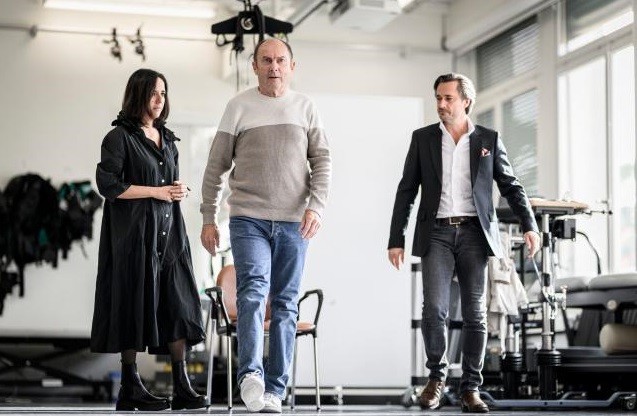07/11/2023
07/11/2023

NEW YORK, Nov 7, (Agencies): A groundbreaking experimental implant that administers electrical stimulation to the spinal cord has made significant strides in improving mobility for an individual suffering from advanced Parkinson's disease. This remarkable development is documented in a report published in Nature Medicine. Developed by a team of researchers from the Swiss Federal Institute of Technology in Lausanne (EPFL), the technology has enabled the patient to walk smoothly and navigate challenging terrain without experiencing debilitating falls — a feat previously unattainable due to the patient's Parkinson's condition, which results in uncontrolled movements and coordination difficulties that progressively worsen over time.
The positive effects of this treatment have endured for two years, representing a significant breakthrough in addressing the severe gait issues that often plague individuals in the later stages of Parkinson's disease. Jocelyne Bloch, a neurosurgeon at EPFL and a leading author of the study, expressed her amazement at witnessing the patient's newfound ability to walk. However, given that this innovative approach has been tested on only one individual, its effectiveness for a broader spectrum of Parkinson's patients remains uncertain. The next crucial step is to conduct a randomized, controlled trial, according to Susan Harkema, a neuroscientist at the University of Louisville in Kentucky who specializes in stimulation therapy for individuals with spinal cord injuries.
Spinal cord stimulation entails the surgical implantation of a neuroprosthetic device that delivers electrical pulses to specific areas of the spinal cord, with the aim of activating malfunctioning neural circuits. This technique has been previously explored in attempts to assist paralyzed individuals with spinal cord injuries in standing and even walking short distances. While it has shown some promise in improving the gait of Parkinson's patients, the results have often been modest, short-lived, or inconsistent, as noted by Bloch. Researchers typically place the implant over the upper and middle spine to modulate sensory signals sent to the brain.
The EPFL research team, however, took a different approach by implanting the neuroprosthesis in the lower back, targeting the lumbosacral spinal cord. This strategic placement allowed the stimulation to activate the network of neurons connecting the spinal cord to the leg muscles. Drawing from their success in applying this strategy to individuals with spinal cord injuries, the team believed it could be adapted to benefit those with Parkinson's.
To tailor the stimulation for the specific needs of their patient, Marc Gauthier, the participant in the study, the researchers employed sensors on his feet and legs to collect data on his walking deficiencies and patterns. They then customized the stimulation to address any issues, such as weak knee extension or muscle contraction problems in the buttocks.
Grégoire Courtine, the neuroscientist at EPFL responsible for developing the technique, emphasized their precision in stimulating the spinal cord to adjust leg movement. The novelty of their approach lies in utilizing this understanding and technology for the benefit of Parkinson's patients.
Nonetheless, whether Courtine's strategy represents a definitive breakthrough in spinal cord stimulation for Parkinson's remains uncertain. Susan Harkema cautions that the data in this paper may not be sufficient to conclude that this approach surpasses current standard treatments. While numerous studies have explored the potential of spinal cord stimulation to improve gait in Parkinson's patients, most have involved only a small number of participants, leaving the efficacy of the treatment in question. Larger-scale studies are urgently needed in this field.
Bloch and Courtine plan to extend their stimulation treatment to six more Parkinson's patients in the coming year. In the meantime, Marc Gauthier has experienced a remarkable improvement in his quality of life. Prior to the procedure, he faced the challenging issue of "freezing of gait," where his legs would suddenly become immobilized during movement, causing him to fall frequently and limiting his ability to perform daily activities. Gauthier, a former architect and town mayor near Bordeaux, France, had previously received conventional Parkinson's treatments, including deep brain stimulation (DBS), which helped alleviate some symptoms but failed to resolve his gait problems.
In their study, Courtine and Bloch investigated the impact of spinal stimulation on its own and in conjunction with DBS. They discovered that combining both stimulators yielded the most favorable results. Advanced DBS systems have the capability to record brain activity, and the researchers are working on a strategy to leverage these recordings to understand the electrical signatures associated with freezing of gait. This data could potentially be used in a feedback mode to stimulate the spinal cord precisely when the legs require it the most.


